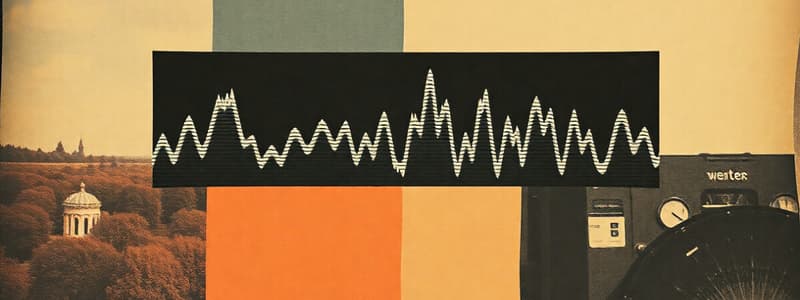Podcast
Questions and Answers
What is the primary function of a digital frequency meter (DFM)?
What is the primary function of a digital frequency meter (DFM)?
- To measure capacitance values directly
- To count cycles of a signal over time (correct)
- To display current in a circuit
- To measure voltage drop across a capacitor
Which of the following statements best describes the working principle of a DFM based on straight counting?
Which of the following statements best describes the working principle of a DFM based on straight counting?
- It can only measure high frequencies accurately
- It uses analog signals to display frequency
- It requires calibration for every measurement
- It counts the number of pulses in a time interval (correct)
In the context of frequency measurement, what is considered a pulse?
In the context of frequency measurement, what is considered a pulse?
- A discrete change in voltage or current in a circuit (correct)
- A signal that is only present at high frequencies
- A constant signal with no fluctuations
- A continuous wave propagating through a medium
What is a key advantage of using a digital frequency meter over analog methods?
What is a key advantage of using a digital frequency meter over analog methods?
Which situation would most likely result in an incorrect frequency measurement by a DFM?
Which situation would most likely result in an incorrect frequency measurement by a DFM?
What component receives the 1 MHz oscillator frequency in the rearranged frequency meter system?
What component receives the 1 MHz oscillator frequency in the rearranged frequency meter system?
What is the main purpose of the frequency meter system mentioned?
What is the main purpose of the frequency meter system mentioned?
In the described frequency meter system, what does the oscillator frequency represent?
In the described frequency meter system, what does the oscillator frequency represent?
What is the effect of replacing the wave-shaping circuit output with the oscillator frequency?
What is the effect of replacing the wave-shaping circuit output with the oscillator frequency?
What type of system is being discussed in relation to reciprocal counting?
What type of system is being discussed in relation to reciprocal counting?
What triggers the change of state in the flip-flop?
What triggers the change of state in the flip-flop?
What triggers the reset of the counting circuits to the zero-count condition?
What triggers the reset of the counting circuits to the zero-count condition?
Which component is responsible for controlling the flip-flop's state changes?
Which component is responsible for controlling the flip-flop's state changes?
What aspect of the timer output waveform is critical for the flip-flop's operation?
What aspect of the timer output waveform is critical for the flip-flop's operation?
What ensures that the count always starts from zero?
What ensures that the count always starts from zero?
Which of the following statements is true regarding the timing circuit and flip-flop interaction?
Which of the following statements is true regarding the timing circuit and flip-flop interaction?
Which of the following statements is true regarding the counting circuits?
Which of the following statements is true regarding the counting circuits?
What is the output signal from the flip-flop that performs the reset function?
What is the output signal from the flip-flop that performs the reset function?
In digital circuits, why is the behavior of the flip-flop at the negative-going edge important?
In digital circuits, why is the behavior of the flip-flop at the negative-going edge important?
When the counting circuits are reset, what condition do they return to?
When the counting circuits are reset, what condition do they return to?
What role does the reshaped input wave play in the system described?
What role does the reshaped input wave play in the system described?
What frequency does the oscillator operate at in this arrangement?
What frequency does the oscillator operate at in this arrangement?
During what time period does the AND gate pass pulses to the counting circuits?
During what time period does the AND gate pass pulses to the counting circuits?
What is the relationship between the reshaped input wave and the counting circuits?
What is the relationship between the reshaped input wave and the counting circuits?
If the ramp time (t1) were to double, how many clock pulses would be counted at the same frequency?
If the ramp time (t1) were to double, how many clock pulses would be counted at the same frequency?
What is the primary function of the AND gate in this setup?
What is the primary function of the AND gate in this setup?
What is the purpose of the clock pulses counted during the ramp time?
What is the purpose of the clock pulses counted during the ramp time?
What is the ramp time (t1) mentioned for the digital voltmeter?
What is the ramp time (t1) mentioned for the digital voltmeter?
How many clock pulses are counted when the clock generator frequency is 1 kHz for a ramp time of 1 second?
How many clock pulses are counted when the clock generator frequency is 1 kHz for a ramp time of 1 second?
What clock generator frequency corresponds to the scenario described?
What clock generator frequency corresponds to the scenario described?
Flashcards
Digital Frequency Meter (DFM)
Digital Frequency Meter (DFM)
A device used to measure frequency, typically by counting cycles of an input signal within a fixed time period. It's commonly used in electronics for various measurements, such as signal analysis, power conditioning, and more.
Straight Counting (Frequency Measurement)
Straight Counting (Frequency Measurement)
A method of frequency measurement where the DFM directly counts the number of cycles of an input signal within a defined time interval. This provides a direct and accurate reading of the frequency.
Frequency
Frequency
The time taken for one complete cycle of an oscillating signal. It's often measured in Hertz (Hz), where 1 Hz is one cycle per second.
Capacitance
Capacitance
Signup and view all the flashcards
Capacitor
Capacitor
Signup and view all the flashcards
Flip-flop
Flip-flop
Signup and view all the flashcards
Timing Circuit
Timing Circuit
Signup and view all the flashcards
Negative-going edge
Negative-going edge
Signup and view all the flashcards
Flip-flop state change trigger
Flip-flop state change trigger
Signup and view all the flashcards
Negative direction of timer output waveform
Negative direction of timer output waveform
Signup and view all the flashcards
Input wave
Input wave
Signup and view all the flashcards
1 MHz oscillator
1 MHz oscillator
Signup and view all the flashcards
AND gate
AND gate
Signup and view all the flashcards
Counting circuits
Counting circuits
Signup and view all the flashcards
DFM (Direct Frequency Measurement)
DFM (Direct Frequency Measurement)
Signup and view all the flashcards
Reciprocal Counting
Reciprocal Counting
Signup and view all the flashcards
Time Base
Time Base
Signup and view all the flashcards
Wave-shaping
Wave-shaping
Signup and view all the flashcards
Resetting a counting circuit
Resetting a counting circuit
Signup and view all the flashcards
Negative-going edge of the ܳത output
Negative-going edge of the ܳത output
Signup and view all the flashcards
Zero-count condition
Zero-count condition
Signup and view all the flashcards
Count always starts from zero
Count always starts from zero
Signup and view all the flashcards
Ramp Time (t1)
Ramp Time (t1)
Signup and view all the flashcards
Ramp Rate
Ramp Rate
Signup and view all the flashcards
Clock Generator Frequency
Clock Generator Frequency
Signup and view all the flashcards
Pulse Count
Pulse Count
Signup and view all the flashcards
Voltage Measurement
Voltage Measurement
Signup and view all the flashcards
Study Notes
Digital Frequency Meter (DFM)
- DFM uses a timing source, counting circuits, waveform shaping, and gating circuits
- Input signal is amplified/attenuated, then shaped into a square/pulse waveform
- Shaped waveform is fed into an AND gate; the other input of the gate is controlled by a flip-flop's Q output
- Pulses are counted only when the flip-flop's Q terminal is high
Waveform Shaping/Schmitt Trigger
- Converts input waveforms (sinusoidal, square, triangular, etc.) into a square/pulse waveform
- Maintains same frequency as input
Range Changing
- Flip-flops divide the input frequency by 2
- Decade counters divide input frequency by 10
- Using a crystal oscillator and decade counters creates time periods of 10 μs, 100 μs, 1 ms, 100 ms, 1 s
- Allows for selection of different frequency ranges by choosing appropriate time periods
Frequency Division using Flip-Flops
- Each flip-flop divides the input frequency by 2
- If there are multiple flip-flops, the frequency is divided by 2n where n is the number of flip-flops.
Frequency Division Using Decade Counters
- Each decade counter divides the input frequency by 10
- Combination of counters creates various time periods for frequency measurement
Selection of Time Period and Decimal Point
- Switching arrangement selects the time period for measurements and the appropriate decimal point for display (kHz, MHz etc)
- Switching the time base changes the displayed frequency and decimal point position
Example 1 Solution
- Example demonstrating how to calculate the measured frequency using a digital frequency meter with a 1 MHz clock generator, divided by decade counters
- Calculations provided for different time base configurations (six-decade counters, four decade counters)
Example 2 Solution
- Examples of error calculations for measuring 100 Hz, 1 MHz, and 100 MHz frequencies
- Demonstrates the impact of error sources on frequency measurement ( time base error, +/- 1 LSD)
Reciprocal Counting
- The input waveform directly toggles the flip-flop instead of shaping it
- 1 MHz oscillator frequency is applied directly to the AND gate
- The time period of the input signal results in counted clock pulses
- Method gives more accurate results for high frequencies but still susceptible to ±1 LSD error
Capacitance Measurement on Digital Multimeters
- Some digital multimeters include capacitance measurement by charging a capacitor at a constant rate and monitoring the time taken for a given terminal voltage
- The Ramp Generator Digital Voltmeter system uses a constant current to charge a capacitor for capacitance measurement
Studying That Suits You
Use AI to generate personalized quizzes and flashcards to suit your learning preferences.
Related Documents
Description
This quiz focuses on the principles and components of Digital Frequency Meters including waveform shaping, flip-flops, and frequency division. You will explore how these technologies work together to accurately measure and manipulate frequency signals. Test your knowledge on various concepts including timing sources, gating circuits, and range changing methods.




